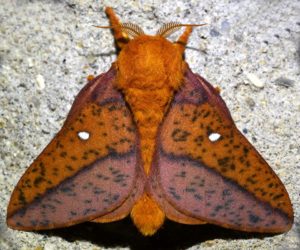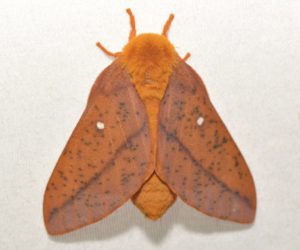Spiny Oakworm Moth (Anisota stigma)
The spiny oakworm moth is a member of the family of saturniid moths found in Canada and the United States. They are named because of the presence of spines on the caterpillars.
indiananature.net
Scientific Classification
- Family: Saturniidae
- Genus: Anisota
- Scientific Name: Anisota stigma
Description and Identification
Caterpillar
The larva is brown, with an orange-brown head. As its name suggests, their body has an entirely spiny appearance, covered with two black spines, protruding from either side of the black stripe running down their backs. The spines close to their head seem immensely long. Besides the spiny projections, their whole body remain covered with white dots.
They are known to voraciously feed on oak leaves, often eating in groups during their initial instars. In fact, a cluster of spiny oak worm caterpillars have the ability of defoliating a young oak tree.
Pupa
They pupate underground in the winter.
Adult Moth
Sexual Dimorphism: Present. The males are more reddish than the females.
Color and Appearance
Forewing: When the wings are opened, two segments are observed – an upper orange-brown part and a lower purple-pink part. A purple line separates them. There are two white spots present on them while they are also covered with black freckles. When the wings are closed, the orange-brown and purplish-pink spots with the two dots remain visible.
Hindwing: When the wings are opened, they are similar in color to the forewings, with prominent black freckles on the lower edge. When the wings are closed, the color remains the same, while the black freckles are visible in the lower edge.
They even have a orangish furry head, orange-brown thorax and abdomen, and a purplish-pink shoulder,
Average wingspan: 4-7 cm
Flight pattern: Consistent
Season: Summer
Egg
Females lay the eggs in clusters of 5-20, which take 2 weeks to hatch.
Quick Facts
| Distribution | Florida, Massachusetts, southern Ontario, west to Minnesota, Kansas, and Texas |
| Habitat | Deciduous woods |
| Lifespan of Adults | About a month |
| Host Plants | Primarily oak, but also basswood and hazel |
| Adult Diet | Does not feed |
Scientific Classification
- Family: Saturniidae
- Genus: Anisota
- Scientific Name: Anisota stigma




